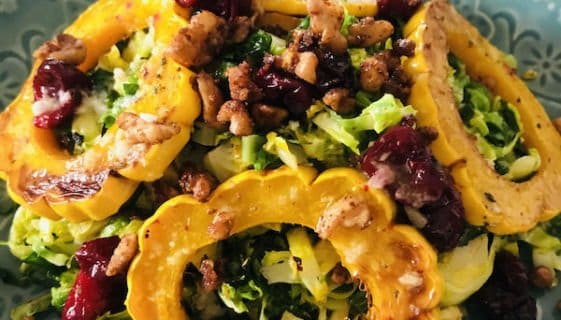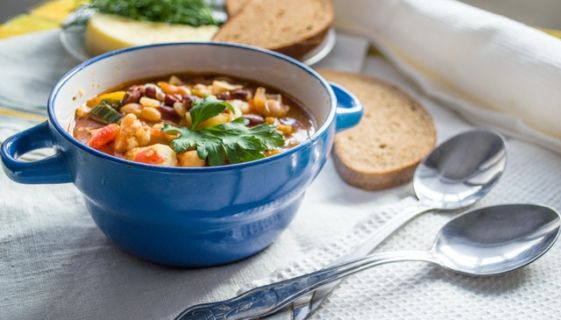Enjoy the fresh flavors of summer with these quick and zesty kebabs! Shrimp are low in saturated fat and high in Omega-3 fats, making it an excellent protein source for an anti-inflammatory eating pattern. Shrimp also provide potassium, iodine, and astaxanthin – an antioxidant from the algae shrimp eat that gives shrimp its pinkish coloring when cooked. Paired with colorful vegetables, these shrimp kebabs provide a balanced, tasty, and satisfying meal.
This recipe is flexible and can be enjoyed substituting artichokes or chicken for the shrimp. It can also be oven-roasted instead of grilled. See below for tips on using substitutions and selecting high-quality shrimp.
– Melanya Kushla, MS, RD, CHES at Taste & Thrive LLC
Summer Shrimp and Veggie Kebabs
Yield: 2 servings
Serving Size: 5 skewers each
Ingredients
Dressing:
2 Tablespoons lemon juice
1 Tablespoon olive oil
½ teaspoon garlic paste, or 1 clove minced
¼ Tablespoon dried oregano
⅛ teaspoon salt
⅛ teaspoon paprika
⅛ teaspoon black pepper
Kebabs:
20 large raw shrimp, peeled, deveined
1 small zucchini or head of broccoli
½ package of cherry tomatoes (~¾ cup)
10 bamboo skewers
Utensils
Measuring spoons, cutting board, Chef’s knife, 4 small bowls, 10 skewers, pastry brush (if available), tongs, griddle or grill
Directions
- In a small bowl, combine the lemon juice, olive oil, garlic, oregano, salt, paprika, and black pepper. Set aside.
- Cut the zucchini in half lengthwise, then slice into half circles, about a half-inch wide.
- Place the zucchini in one bowl, the tomatoes in another, and the shrimp in the third bowl.
- Assemble the skewers: add a tomato, then a shrimp, then a piece of zucchini; repeat again so each skewer has 2 of each item on it.
- Heat a griddle or a grill to medium-high heat, or about 400°F.
- Using a pastry brush, gently coat the skewers in the lemon dressing you made earlier, while your cooking appliance of choice is pre-heating. If you prefer, the dressing can also be added after cooking.
- Once hot, line the cooking surface with the skewers. Cook for 6-8 minutes, turning them to the other side about halfway through cooking, using tongs.
- They are done when the shrimp turns an opaque pink or reaches a minimum internal temperature of 145°F.
Notes:
- Choose whatever vegetables you prefer to use- try to get at least 2 different colors for nutrient variety
- If you do not have a pastry brush, simply drizzle the lemon dressing over the kebabs
- This recipe does well as a chopped, cold salad and leftovers will keep for up to 3 days in the refrigerator
Nutrition Info
(Per Serving)
266 calories – 5g fat – 0.9g sat fat – 16g carbohydrates – 44g protein – 7g fiber – 331 mg sodium
Selecting shrimp
Like most of our food, the quality of shrimp has a lot to do with where it comes from and how it was cultivated. Here are some suggestions for choosing higher-quality shrimp and other seafood:
- Opt for frozen, if not live. Unless you have access to live shrimp being harvested right off the coast, you are better off purchasing frozen shrimp, as there is no way to know how long they’ve been sitting defrosted; this increases the risk of foodborne illness as well as decreases the quality of the shrimp. Shrimp should be kept frozen until ready to cook, as the frozen temperature prevents the growth of toxin-producing bacteria that can lead to food poisoning.
- Look for additives. Shrimp are occasionally treated with additives to increase their thawed shelf life or to get them to retain water and plump them up so they can be sold as larger shrimp. Before purchasing, always double-check the packaging and make certain that “shrimp” is the only ingredient listed.
- Quality sourcing. There are many different sources of shrimp and what you have available depends largely on where you live. In general, freshwater shrimp tend to be the more environmentally friendly option, however, you will want to determine how and where it is farmed. Shrimp are susceptible to absorbing chemicals and pollution from their surroundings, so you’ll want to purchase shrimp from a supplier that is conscientious about the water quality. Look for the source of the shrimp on the packaging and do a little digging into the company to determine if the shrimp is sustainably sourced.
- Be aware of labeling. Independent regulatory groups will identify shrimp sources that meet certain farming and sourcing standards, such as the Marine Stewardship Council, the Aquaculture Stewardship Council, and Naturland. Be wary of terms such as “sustainable,” or “natural,” as they have no legal standing; these types of descriptive words have no regulation or compliance attached to them.
Substitutes for shrimp
Not everyone likes shrimp or has access to high-quality shrimp, so alternatives can easily be swapped in at your preference.
- Artichokes. My favorite swap for shellfish in any recipe is artichoke. Artichokes are high in fiber, potassium, and a flavonoid called silymarin which has anti-inflammatory properties and supports healthy liver function. Artichokes are an excellent substitute for shellfish in many dishes as they have a similar texture and briny flavor profile. You can find jarred artichoke hearts at most grocery stores near the pickles and vinegar. Look for artichoke hearts sold in a glass jar with a simple water or vinegar solution. Serve with a side of plain Greek yogurt with fresh garlic mixed in as a dipping sauce for a refreshing complement and some extra protein.
- Chicken. Chicken also does well as a substitute for shrimp but will require a longer cooking time, of 15-20 minutes. It also does not have quite the same seaside flavor profile but is still tasty nonetheless.
Dressing or a marinade?
The flavors in these kebabs come primarily from the lemon dressing- and it is just that, a dressing- not a marinade. –
- Marinades. Marinades are made in larger quantities and usually require about 12-24 hours of extra time ahead of the recipe to allow the vegetables and protein to sit and absorb some of the acid and flavors. Marinades are great for tougher protein, such as chicken, but not necessary for an already tender protein like shrimp. Marinades are also wasteful, with about 80-90% of it going in the garbage after the marinating is done.
- Dressing. These are like marinades in that they impart a burst of flavor, but they are made in much smaller quantities and need only coat the food — no need for soaking! Dressings are versatile and can be added before or after the cooking process, or used to coat the ingredients before assembling the skewers. (Note that coating the ingredients first makes them very slippery and challenging to thread onto the skewer.)
- Basting on a grill. Contrary to popular practice, it is not recommended to baste the grilled kebabs in a marinade while cooking. Basting does not add any more flavor once the food is initially coated and actually increases the formation of polycyclic aromatic hydrocarbons (PAHs), which are carcinogenic compounds produced as fat burns in the flame. Excess fat added to the grill during cooking only burns and produces smoke, which is how the PAHs are formed.
Alternative cooking methods
This recipe translates well to oven-roasting if you do not wish to use a grill or griddle. Simply preheat the oven to 425°F and toss all ingredients together in a bowl, to evenly coat the veggies and shrimp in the dressing. Spread the ingredients out over a baking sheet and roast for 8-10 minutes. Alternatively, you can dry roast the veggies and shrimp, without the dressing, and then drizzle the dressing over after cooking.
Cooking temperatures
Shrimp cook very quickly, which makes them a staple for quick and easy meal preparation. You can tell shrimp are cooked as they will turn from a gray translucent color to an opaque pink.
- Minimum internal temperature. All animal-based proteins have a minimum internal temperature for cooking to ensure the food is safe from harmful bacteria. For shrimp and other seafood, that minimum temperature is 145 °F. A simple thermometer can be picked up at the store for ~$5 and used to take the temperature of your food if you are concerned about undercooking.
- If you are currently undergoing any form of treatment for cancer, such as chemotherapy, radiation, or surgery, I recommend practicing extra precaution when cooking and ensure your food is cooked to the minimum internal temperatures to reduce your risk of contracting a foodborne illness while your body’s immune system is vulnerable.



 Melanya Kushla
Melanya Kushla 

